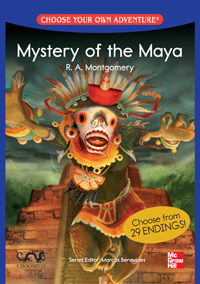curriculum EFL extensive reading graded readers language courses Language learning materials readers Reading teaching university
by sendaiben
6 comments
Choose Your Own Adventure readers -in class!
Today I am going to introduce a new activity I have been doing with extensive reading classes here at Tohoku University this semester. Our ER classes consist of approximately 45 minutes of silent reading and 45 minutes of supplementary activities including speaking, listening, and writing.
One activity that students enjoyed was reading some of the Choose Your Own Adventure readers in groups (I got the idea from Marcos Benevides).
Background Info
The Choose Your Own Adventure books (CYOA from now on) were popular when I was in school. They consist of books where the reader is given choices and the story develops differently based on those choices, up until an ending is reached. Some endings are good and some are bad. It’s kind of like a computer or role-playing game.
The CYOA readers are published by McGraw-Hill Education, and consist of 30 titles over three levels (500, 700, and 900 headwords). I used this in-class reading activity twice, once with Mystery of the Maya, and once with Cup of Death. Both are at the 500 headword level.
Procedure
The activity takes 30-35 minutes. First, introduce the concept of gamebooks to the students and walk them through the ‘read a page, decide on a course of action, go to the next page’ dynamic.
Assign the students to random groups (we found pairs and groups of three work best, as larger groups mean each student has too little to do). Explain that each group member will in turn read a page, the group will make the decision, and the book will be passed to the next member. This will continue until an ending is reached. If groups finish early they should go back and try to get another ending.
The teacher then reads the first page to the class before distributing one book to each group. Once a group has their book, they can start.
Results
We did this activity twice with about a dozen classes. Students actively read, listened, and discussed options for the whole time the activity went on. Many students enjoyed the activity and were clearly happy when teachers introduced the second book (three weeks after the first one). The highly structured nature of the activity makes it easy for students to participate.
Evaluation
This is a great activity to do two or three times a semester. It would be possible to base an entire course around reading CYOA books, but I suspect the novelty might wear off. Of course, as with any activity, not all students enjoyed it to the same extent. In terms of materials, one class set can be shared among several teachers.
The best thing about this activity is that it really brings out the meaning in the books: students have to understand the text in order to choose their next action.
Improvements
1. The content of each book in the CYOA series varies considerably. Our students had some trouble with the Mayan setting, so it might have been useful to pre-teach some of the background, the geography, and the history. This could be done in a few minutes. Going through the proper nouns in the book would also help students read more smoothly.
2. Doing the exercise in pairs gives more reading/speaking time to each student.
3. It is not necessary to have class sets of each book: the same activity could be done with each group/pair reading a different book (of course, pre-teaching and having the teacher read the first page would not be possible in this case). This would allow students to choose which book they wanted to read, possibly making it more interesting for them.
Conclusion
This was a very positive experience for my colleague and I, and for the students. It is likely to become a regular activity in our ER classes.
The JALT Vocabulary SIG Symposium
I was lucky enough to be able to attend this year’s JALT Vocabulary SIG Symposium on Saturday in Fukuoka. It was the first time for me to attend the event, and I found it useful enough to put it on my list to attend next year.
The format for the symposium was to have two sessions, one in the morning and one in the afternoon, with a poster session/lunch in between. Each session consisted of four twenty-minute presentations of research followed by comments from a discussant (this year Paul Nation and Yo In’nami served in this role).
Apart from the fact that it was held in Fukoka, which has the most convenient airport (5 minutes by subway from the central train station) and possibly the best ramen in Japan, the symposium had several other things going for it:
- the quality of presentations was high
- having a discussant comment on the research papers gave powerful insight into how to approach research
- having the entire symposium in one room allowed all the participants to have the same experience
- the venue was conveniently located ten minutes by subway from the city centre
- the organization was very smooth, with signs and volunteer guides, coffee sessions, and a well-organized poster session
Basically I was very impressed and recommend future Vocabulary SIG events -hope to see you at one in the future!
Google Reader
Just a very quick reminder that if you follow this blog’s RSS feed using Google Reader, it will be switched off on Monday.
I’m disappointed, as I find it a really useful tool, but I have found two passable alternatives:
Feedly
Digg Reader
I’ve also been changing over to following blogs through email subscription. Please consider doing that by signing up in the box on the top right.
More teaching stuff next week!
EFL extensive reading high school junior high school materials online resources Reading reviews self-study teaching
by sendaiben
2 comments
Online news site for English learners
Finally, a post about teaching 🙂
I found a nice online news site this week, and have been trying it with some of my classes. I’m going to introduce the site’s functionality, my experience of using it, and then evaluate the benefits and drawbacks of using the site.
Functionality
The News in Levels website features news stories written specially for learners of English. They have three or four versions of each story (from basic or easy to more challenging), along with a video. The stories are interesting and the various difficulty levels are useful.
My experience
I used the site with some junior high school and high school classes. After choosing a story, I had students read level one and answered their questions. They we read level two together. Finally we watched the video. It was a quick and successful lesson with several groups. The site also worked well with individual students.
Good and bad points
Good:
- interesting stories
- good presentation
- texts and video
- a large number of stories on the site
- free
Bad:
- many of the texts have mistakes/typos. Missing words, spelling mistakes, strange phrasing. It would be safest to check everything first, although this could also result in some teaching moments
- the leveling isn’t always great. Sometimes the same sentences are used in two different levels
- prominent advertising throughout the site
Overall
I liked this site very much. I think it has a lot of potential as long as teachers and learners are aware of the shortcomings. Could be a good resource to allow learners to move on to higher-level texts. Worth a look.
If you have any other good websites you can recommend, please leave a comment below 🙂
career expectations jobhunting life in Japan presentations public policy technology TED
by sendaiben
leave a comment
TED Talk: What will future jobs look like?
Here’s an optimistic TED talk on yesterday’s topic (thanks Tom!).


